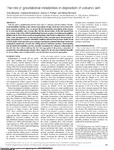The role of gravitational instabilities in deposition of volcanic ash
| dc.contributor.author | Manzella, Irene | |
| dc.contributor.author | Bonadonna, C | |
| dc.contributor.author | Phillips, JC | |
| dc.contributor.author | Monnard, H | |
| dc.date.accessioned | 2019-05-13T09:05:06Z | |
| dc.date.available | 2019-05-13T09:05:06Z | |
| dc.date.issued | 2015-03 | |
| dc.identifier.issn | 0091-7613 | |
| dc.identifier.issn | 1943-2682 | |
| dc.identifier.uri | http://hdl.handle.net/10026.1/13846 | |
| dc.description.abstract |
Volcanic ash is a significant hazard for areas close to volcanoes and for aviation. Gravitational instabilities forming at the bottom of spreading volcanic clouds have been observed in many explosive eruptions. Here we present the first quantitative description of the dynamics of such instabilities, and correlate this with the characteristics of the fall deposit from observations of the 4 May 2010 Eyjafjallajökull (Iceland) eruption. Gravitational instabilities initially took the form of downward-propagating fingers that formed continuously at the base of the cloud, and appeared to be advected passively at the crosswind speed. Measurements of finger propagation are consistent with initial conditions inferred from previous studies of ash cloud dynamics. Dedicated laboratory analogue experiments confirmed that finger downward propagation significantly exceeded the settling speed of individual particles, demonstrating that gravitational instabilities provide a possible mechanism for enhanced sedimentation of fine ash. Our observations challenge the view that aggregation is the primary explanation of proximal fine ash sedimentation, and give direct support for the role of gravitational instabilities in providing regions of high particle concentration that can promote aggregation. | |
| dc.format.extent | 211-214 | |
| dc.language | en | |
| dc.language.iso | en | |
| dc.publisher | Geological Society of America | |
| dc.title | The role of gravitational instabilities in deposition of volcanic ash | |
| dc.type | journal-article | |
| dc.type | Journal Article | |
| plymouth.author-url | https://www.webofscience.com/api/gateway?GWVersion=2&SrcApp=PARTNER_APP&SrcAuth=LinksAMR&KeyUT=WOS:000352096700007&DestLinkType=FullRecord&DestApp=ALL_WOS&UsrCustomerID=11bb513d99f797142bcfeffcc58ea008 | |
| plymouth.issue | 3 | |
| plymouth.volume | 43 | |
| plymouth.publication-status | Published | |
| plymouth.journal | Geology | |
| dc.identifier.doi | 10.1130/g36252.1 | |
| plymouth.organisational-group | /Plymouth | |
| plymouth.organisational-group | /Plymouth/Faculty of Science and Engineering | |
| plymouth.organisational-group | /Plymouth/Faculty of Science and Engineering/School of Geography, Earth and Environmental Sciences | |
| plymouth.organisational-group | /Plymouth/REF 2021 Researchers by UoA | |
| plymouth.organisational-group | /Plymouth/REF 2021 Researchers by UoA/UoA07 Earth Systems and Environmental Sciences | |
| plymouth.organisational-group | /Plymouth/Users by role | |
| plymouth.organisational-group | /Plymouth/Users by role/Academics | |
| plymouth.organisational-group | /Plymouth/Users by role/Researchers in ResearchFish submission | |
| dc.identifier.eissn | 1943-2682 | |
| dc.rights.embargoperiod | Not known | |
| rioxxterms.versionofrecord | 10.1130/g36252.1 | |
| rioxxterms.licenseref.uri | http://www.rioxx.net/licenses/all-rights-reserved | |
| rioxxterms.type | Journal Article/Review |


